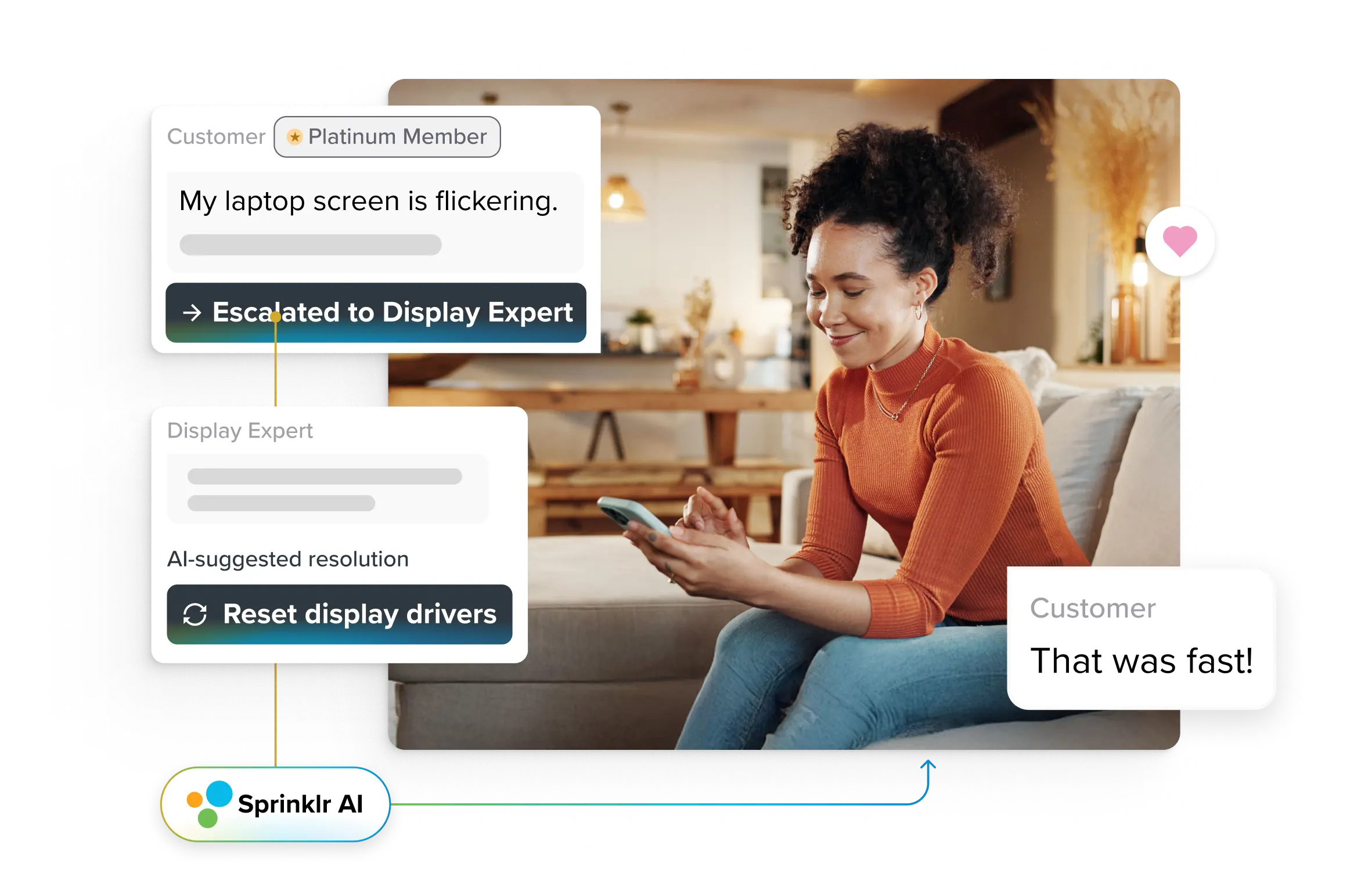Transform CX with AI at the core of every interaction
Unify fragmented interactions across 30+ voice, social and digital channels with an AI-native customer experience platform. Deliver consistent, extraordinary brand experiences at scale.

Self-Service Automation: How It Impacts CX (+Expert Tips)
Equipping customers with self-service options that eliminate the need for live agent intervention has become a top priority for companies of all sizes and industries.
With rising customer expectations and diminishing patience — especially among Millennials and Gen Z — businesses are leaning toward customer self-service solutions. Why? Because they deliver the trifecta of modern customer demands: speed, efficiency and accuracy.
Self-service automation lies at the heart of this shift. When implemented effectively, it transforms the customer experience (CX), driving loyalty and significantly lowering the risk of churn.
In this blog, we’ll explore self-service automation in depth — its definition, core components and how it can elevate CX. Plus, you’ll get actionable tips to ensure you get it right.
What is self-service automation?
Self-service automation empowers customers to resolve issues independently or access information without needing to engage with a human agent. It leverages technologies like AI-powered chatbots, comprehensive knowledge bases and automated workflows to deliver real-time solutions to customer queries.
Across industries, self-service automation takes various forms:
- Retail: Virtual agents guide customers through product searches or returns.
- Banking: AI-driven systems help users reset passwords, check balances, or apply for loans without visiting a branch.
- Healthcare: Patients can use automated portals to schedule appointments, access medical records or get answers to common health queries.
- Travel: Airlines offer self-service tools for booking changes, flight status updates and baggage tracking.
Core components of customer self-service automation
Creating a seamless self-service automation experience requires you to focus on these foundational components:
- Intuitive user interface (UI) A clean, user-friendly design ensures that customers can easily navigate self-service portals or apps. Whether it’s a chatbot interface or a knowledge base, intuitive layouts and minimal clicks to reach solutions are critical for adoption and customer satisfaction.
- Information dissemination at scale
- 📂 Centralized knowledge bases: Comprehensive repositories of FAQs, tutorials and troubleshooting guides empower customers to resolve issues independently.
- 💻 Dynamic content updates: AI-driven systems ensure that knowledge bases, chatbots and self-service portals always provide accurate, up-to-date information.
- 📲 Multi-channel access: Customers can access information seamlessly across platforms, from websites to mobile apps to IVR systems.
- Advanced AI capabilities
- 💬 Natural language processing (NLP): Enables chatbots and virtual assistants to understand and respond to customer queries conversationally.
- 📊 Predictive assistance: AI can preemptively suggest solutions based on customer behavior or query patterns.
- 👥 Personalized Interactions: Tailored responses ensure relevance, making customers feel understood without requiring live assistance.
- Smart automation for resolution
- 🔄 Automated workflows: Handle repetitive tasks like order tracking, appointment scheduling or password resets in real-time.
- 🔧 Integration with backend systems: Real-time data syncing with CRMs, billing systems or inventory databases ensures accurate and actionable resolutions.
- 🔂 Trigger-based actions: Automations like follow-ups or reminders based on customer behavior eliminate delays in service resolution.
Advantages of self-service automation
Self-service automation offers multiple advantages for businesses looking to enhance customer experience and streamline operations. Let’s explore some key benefits.
24x7 availability
One of the most impactful benefits of self-service automation is its constant availability. Automated systems like chatbots, knowledge bases and ticketing tools operate around the clock, enabling customers to find answers or resolve issues anytime, anywhere.
For example, Amazon’s self-service portals allow customers to track orders, request refunds or troubleshoot issues at their convenience. This reduces customer frustration and minimizes dependency on contact center agents, especially during peak hours or holidays.
Scalability
As businesses grow, the volume of customer inquiries often increases exponentially. Unlike human teams that require hiring, training and scaling resources, self-service automation scales seamlessly to meet rising demand.
Improved customer satisfaction
As mentioned earlier, customers appreciate quick, convenient solutions to their problems. With self-service automation, they can find answers faster and without contacting support. This boosts customer satisfaction by reducing wait times and delivering consistent results.
Apple is well-known for its commitment to customer satisfaction and its self-service options reflect this dedication. The Apple Support app provides users with access to a comprehensive knowledge base, troubleshooting guides and the ability to schedule service appointments. Apple has significantly enhanced its customer satisfaction ratings by allowing customers to find solutions independently and manage their devices effectively.
Enhanced user experience
A key advantage of self-service automation is its ability to personalize and enrich the user experience. With technologies like AI and machine learning, you can analyze customer behavior in real time and provide relevant solutions instantly.
For example, Spotify’s Help Center leverages automated tools to offer users curated solutions, troubleshooting guides and account management options. This personalized, responsive approach aligns with modern customer expectations — 63% of whom demand personalized engagement as a standard service.
Integration with omnichannel support
The true strength of self-service automation lies in its ability to integrate seamlessly with other customer service channels. A unified approach ensures customers can switch effortlessly between automated tools and live support while retaining context.
For instance, a customer might begin interacting with a chatbot to resolve a query. If the issue requires escalation, they can transition to a live agent with access to the conversation history. Similarly, automation tools can categorize social media mentions or email queries, routing them to the appropriate teams for resolution.
How self-service automation enhances CX [+ 6 impact points]
Let’s break down how self-service automation can empower you to resolve issues quickly and efficiently and transform customer experience.
1. No more waiting in the call queue
Self-service automation helps you deliver rapid solutions, significantly reducing resolution times. Customers no longer need to endure long call queues or rely solely on human agents. Instead, AI-powered chatbots and intelligent self-service platforms provide instant access to solutions. These tools leverage sophisticated conversational AI to guide customers step-by-step through troubleshooting, enabling real-time resolution without human intervention.
2. Lesser escalations
A common frustration in customer support is the inability to resolve issues during the first interaction. This often leads to repeat inquiries, increased frustration and a higher customer churn risk.
Self-service automation addresses this by offering intelligent options like FAQ chatbots and dynamic knowledge bases. These tools provide precise, relevant information that resolves issues on the first attempt, eliminating the need for repeated interactions and empowering customers to find solutions independently.
Related Read: Escalation Management: How to Manage It Effectively
3. Personalized customer experience across channels
Today’s customers expect personalized support that caters to their unique needs and preferences. A lack of personalization can result in customer dissatisfaction and lost trust in the brand.
Modern self-service solutions, powered by AI and machine learning, analyze past customer interactions to personalize the support experience. Chatbots dynamically tailor responses, suggest relevant solutions and remember preferences from previous engagements across communication channels. This personalized touch enhances customer satisfaction and strengthens the relationship with your brand.
😊 Good to know
Apart from chatbots, with Sprinklr, you can also create your brand-compliant voice bot and deploy it seamlessly across 15+ channels (including voice) in over 100 languages. This ensures that language barriers never hinder exceptional customer support.

4. Reduced customer effort
Customers value simplicity and convenience and high-effort experiences can lead to dissatisfaction and churn. Complex support systems, repetitive explanations or long wait times often leave customers feeling undervalued.
Self-service automation makes finding solutions effortless while offering clear escalation paths for complex issues, ensuring seamless transitions to human support without customers having to start over.
By analyzing self-service interactions, you can identify bottlenecks and refine processes, making data-driven improvements to reduce customer effort over time.
5. Consistent service through clear workflows
Fragmented experiences can erode trust and satisfaction, especially when customers encounter inconsistencies in service.
Self-service automation eliminates this by following predefined workflows tailored to specific customer needs. As use cases grow, these workflows evolve and refine over time, ensuring that customers always receive consistent, high-quality service. For example, an e-commerce platform might use automated order tracking tools that deliver accurate updates at every stage, regardless of the volume of inquiries.
6. Empowers customers with control and independence
Today's customers value autonomy. They prefer tools that empower them to solve issues at their convenience without depending on others.
Self-service automation puts control directly in customers' hands. These tools offer independence and flexibility, from managing subscriptions to updating account details or troubleshooting common issues. For instance, telecom companies often provide self-service portals where users can monitor data usage, modify plans or resolve network issues with just a few clicks.
Top tips for using self-service automation
Implementing self-service automation can transform your customer support landscape, but success depends on avoiding common pitfalls and optimizing your tools with strategy and foresight. Let’s explore some expert-backed tips to ensure your automation efforts deliver maximum value.
1. Start with customer-centric design
Self-service systems designed without understanding your customers result in frustration and abandonment. To avoid this, create workflows catering to your customer's specific needs. Dive deep into their preferences by conducting customer surveys usability tests, and analyzing past interaction data to identify recurring customer pain points and preferred channels.
Keep refining your tools by integrating customer feedback loops. For instance, if you notice customers frequently abandoning a chatbot mid-conversation, identify and resolve bottlenecks in the interaction flow to improve the experience.
Must Read: Top 11 Customer Feedback Tools for Customer Service in 2024
2. Keep content fresh and relevant
Nothing frustrates customers more than encountering outdated FAQs or irrelevant information. Such lapses confuse and can lead to escalations, eroding trust in your self-service options.
Establish a regular content review process to keep your knowledge base updated and accurate. AI-driven tools can be your ally, auto-suggesting updates based on trending queries or new customer issues. This ensures that your content evolves alongside customer needs.
Did you know
With modern knowledge base software, you can easily create consolidated reports across different channels to analyze performance and identify opportunities for improvement in your existing articles. Additionally, by leveraging agent and customer feedback, you can determine which knowledge base articles are the most helpful and continuously refine your content for better clarity and value.

3. Ensure seamless integration with human support
Not every customer is tech-savvy or wants to handle issues independently. When customers encounter complex problems, they need a clear and smooth path to escalate to human support without repeating their concerns.
To make this possible, design an escalation process where customers can easily transition to a live agent. Intelligent routing plays a crucial role here, directing escalated queries to the most suitable agents based on expertise. This reduces customer frustration and speeds up resolutions, enhancing overall satisfaction.
How Sprinklr helps
Sprinklr’s conversational AI works seamlessly with intelligent routing and customer case management capabilities to ensure smooth escalations. When a case is transferred, all context is passed to the right agent, so your customers don’t have to repeat themselves, and agents can jump straight to resolving the issue. This ensures a faster, more efficient resolution process, elevating customer satisfaction.

4. Test for accessibility and inclusivity
When it comes to customer self-service, one size doesn’t fit all. If your tools fail to meet the needs of diverse user groups, including those with disabilities, you risk alienating segments of your audience.
To address this, ensure your automation systems are inclusive. Add features like voice commands, multi-language customer support and simplified navigation. Conduct accessibility audits and gather feedback from a wide range of testers to identify and fix gaps in your automation tools. An inclusive design benefits everyone and amplifies customer satisfaction.
Empower CX with seamless self-service automation
The pressure on businesses to deliver fast, efficient, personalized customer service is more intense than ever. Yet, many organizations struggle with high customer frustration due to long wait times, inconsistent service and the inability to provide personalized experiences. These challenges can break trust, harm loyalty and ultimately drive customers away.
This is where self-service automation, when done right, can truly make a difference. By leveraging advanced solutions like conversational AI, intelligent routing and up-to-date knowledge bases, you can meet and exceed modern customer expectations. The key is delivering a frictionless experience where customers can resolve issues quickly, access personalized support, and smoothly transition to human agents when needed.
At Sprinklr, we help you turn this vision into reality. Our conversational AI enables intelligent, human-like interactions, while conversational IVR software ensures seamless transitions between self-service and live agents, enhancing resolution times and customer satisfaction. The knowledge base software keeps your content fresh, relevant, and responsive to customer needs, constantly refining itself through real-time feedback.
Book a demo with Sprinklr today and discover how leading companies are building smarter, faster and more reliable systems — so they can focus on what truly matters: their customers. If they can do it, so can you!
Frequently Asked Questions
Businesses can achieve this balance by integrating live chat or chatbot features that allow customers to escalate issues to human agents when needed, ensuring that complex queries receive personalized attention.
Key metrics to track include resolution rates, customer satisfaction scores, deflection rates (how often customers resolve issues without human intervention) and usage statistics of self-service options.
Best practices for training staff on self-service automation include providing comprehensive onboarding to familiarize them with the tools, followed by hands-on training using real-world scenarios. Regular refresher courses and updates on new features keep staff informed. Additionally, ensure clear escalation workflows are in place so staff can seamlessly assist customers when automation is insufficient.
Personalization improves self-service automation by tailoring responses based on customer history and preferences, leading to a more relevant and efficient experience that increases satisfaction.
Organizations can ensure their self-service automation systems stay updated by regularly reviewing and analyzing customer feedback, common queries and emerging trends. Leveraging AI tools to track performance and auto-suggest updates helps keep content relevant. Additionally, conducting periodic audits (half-yearly or annually) and refining workflows based on real-time data ensures the system adapts to evolving customer needs.











